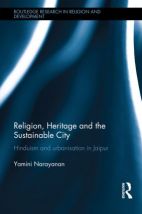Religion, Heritage and the Sustainable City: Hinduism and Urbanisation in Jaipur

Investigation of the links between religion and cities has predominantly focused on Christianized countries in the West. Yamini Narayanan’s book Religion, Heritage and the Sustainable City, which presents research from India on the linkages among religion, heritage, sustainability and gender from a Hindu perspective, is therefore a welcome addition as it broadens the scope to South Asia.
Narayanan acknowledges that India’s greatest development challenge is urbanization and that exploring relevant conceptual frameworks for urban development is vital for India’s future. As sustainable development emerges as a central planning priority, however, Narayanan argues that this concept, when uncritically applied to a developing country like India, can fail and even deepen injustices. Believing that place-sensitive planning is critical to the successful development of sustainable cities, Narayanan’s research focuses in particular on the role of religion as a key contributing factor of place-making in India. Narayanan highlights the influence that religion has in shaping urban India, but also identifies that religion has become a blind spot in mainstream policymaking.
To illustrate the influence of religion on design, planning and development, Narayanan makes a case study of the old-walled city of Jaipur. Narayanan considers Jaipur an ideal case study because of its latent religiosity, and because it is expected to be the fastest growing Tier 2 city (one with a population of 50,000 to 99,999) in India (page 15).
Religion, Heritage and the Sustainable City documents this research and is structured over nine chapters. After Chapter 1’s Introduction, Chapter 2 critiques the planning paradigm of sustainable development for Indian cities, and argues that religion and heritage enable the achievements of social justice and environmental protection through their identification of core urban planning challenges. Following this, an analytical framework for the book is set out.
In Chapter 3, Narayanan discusses religion and heritage in India’s old cities and identifies three challenges of urban development and renewal of India’s old/declining cities.
After looking at trends that include culture and religion in Western planning, Chapter 4 gives a conceptual understanding of Hindu religious heritage and how this relates specifically to spatiality, gender and the environment in India’s urban development.
The case study of the old-walled city of Jaipur begins in Chapter 5. Here Narayanan explores the nexus between religion and urban development, and its relevance for contemporary planning in the old city.
Chapters 6, 7 and 8 form the primary research of Narayanan’s book, with Chapter 6 showing how the Hindu religion contributes to place-making by playing a role in regulating spatial relationships between Hindus and Muslims that are relevant for urban planning (page 18).
Chapter 7 takes a gendered perspective as it examines the influence of the Hindu religion upon women’s sense of place.
Finally, the nexus among religion, heritage and the natural environment is discussed in Chapter 8, where Narayanan identifies heritage impacts upon place-making in relation to four specific environmental issues.
The book concludes in Chapter 9 with an analysis of how religion and heritage intersect with urban planning in India. Narayanan furthermore draws out lessons learnt from her research of Jaipur that may be applied elsewhere. She emphasizes the urgent need for a “bioreligious” approach in urban policy in order to develop sustainable cities (page 206).
Book note prepared by Hannah Keren Lee
Search the Book notes database
Our Book notes database contains details and summaries of all the publications included in Book notes since 1993 - with details on how to obtain/download.
Use the search form above, or visit the Book notes landing page for more options and latest content.
For a searchable database for papers in Environment and Urbanization, go to http://eau.sagepub.com/

